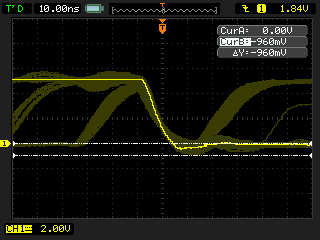A new version of this project is available here
 The apple IIgs is the most advanced computer in the Apple II series. Equipped with a 65c816 8/16-bit CPU with 24-bit address space it could address up to 16MB of memory. The original rom 01 model shipped with 256KB of fast RAM, the revised rom 3 shipped with 1MB (both had an additional 128KB of standard RAM and 64KB of sound RAM). RAMGS is a newly designed 4MB expansion card for this great classic computer.
The apple IIgs is the most advanced computer in the Apple II series. Equipped with a 65c816 8/16-bit CPU with 24-bit address space it could address up to 16MB of memory. The original rom 01 model shipped with 256KB of fast RAM, the revised rom 3 shipped with 1MB (both had an additional 128KB of standard RAM and 64KB of sound RAM). RAMGS is a newly designed 4MB expansion card for this great classic computer.
The design team goal was to build a small card to keep cost down but still try to keep a vintage look to the design. We ended up with a full PTH design using 4Mbit fast page DRAMs in a ZIP package. The schematics is very similar to the original Apple memory expansion card and many other clones of the time.
U1 is a bi-directional buffer for the data bus. A low on the CSEL signal is required to read the DRAM data. The address buffers from the older A01 PCB have been replaced with series termination. U2 decodes the RAM bank from the CROW0 and CROW1 signals.
The only modern twist is the addition of the U3-U4 circuit to add support for the 4Mbit DRAMs (see section at the end of the article for a detailed explanation).
The card can be configured for 1, 2 or 4MB (the 3MB configuration is not supported as recommended in the Apple documentation).
| Configuration | J1 | J2 | Memories |
|---|---|---|---|
| 1MB | off | off | M1, M2 |
| 2MB | on | off | M1, M2, M3, M4 |
| 4MB | on | on | M1-M8 |
The card accepts most fast page mode 1Mx4 DRAMs in the ZIP-20 package. Refer to the table below for part numbers.
| Manufacturer | Part Number |
|---|---|
| Siemens | HYB514400 |
| Toshiba | TC514400 |
| Hitachi | HM514400 |
| NEC | uPD424400 |
| Mitsubishi | M5M541000 |
| Oki | MSM514400 |
| Fujitsu | MB814400 |
| Samsung | KM44C1000 |
| Micron | MT4C4001 |
| TI | TMS44400 |
Address Drive Strength
Most vintage expansion cards buffer the address to the drams on the card. After extensive probing on our previous A01 cards it turns out that the buffers are unnecessary on the ramgs because of the limited loading (just 8 devices) and short traces (about 80mm). For comparisons the apple 1MB expansion card has 32 loads and traces exceeding 300mm. Actually the FPI I/O drive is already too strong for the ramgs layout given the negative overshoot exceeds 2V in the scope captures.

Adding series termination on the address lines reduces the overshoot at the expense of slower rise and fall time. The following two images show the effect of 56ohm and 100ohm series termination.


4Mbit Support
The Apple IIgs seems to perform only standard read cycles, early write cycles and CAS before RAS refresh cycles. We have not seen any fast page mode nor read-modify-write cycles.
Upon close inspection of the memory datasheets is clear that the CAS before RAS refresh cycle is different between the 1Mbit and the 4Mbit parts. In particular, the 4Mbit devices require WE to be high at the falling edge of RAS (WE is a don't care in the 1Mbit devices). Issuing a RAS before CAS refresh cycle with WE low on the 4Mbit DRAM enables the device test mode.


The IIgs follows the 1Mbit specification and the state of WE during a refresh cycle is undetermined (it is actually the state left by the transaction right before the refresh cycle). This behavior randomly enables the test mode in the memories with catastrophic results to the running programs.

The the gates U5D, U5C and the flip-flop U6A form a refresh cycle detector. The Q output of the flip-flop is high if the system is performing a RAS before CAS refresh cycle. The flip-flop will latch the value of RAS at every falling edge for CAS (this will be high only during a RAS before CAS cycle). In any case the flip-flop will be cleared on the rising edge of CAS (all cycle types end with CAS de-assertion).
Based on the output of the flip-flop, U5A and U5B force WE high if a refresh cycle is in progress.

BOM Notes
U3 (quad NAND) and U4 (dual D flip-flop) propagation delay is critical for the proper operating of the card. U3 should be HCT, F, ALS or ACT. U4 should be F, ALS or ACT. For best signal integrity U1 and U2 should be standard LS.
Component Assembly
Our friends at Apple IIoz have created a step by step tutorial with many high resolution pictures on how to assemble the cards.
